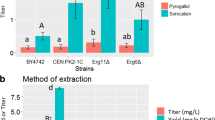Abstract
Efficient synthesis of large numbers of viable sphaeroplast from Saccharomyces cerevisiae has been found to be influenced by a number of factors. In this case, Trichoderma harzianum, NCIM 1185, culture filtrate has been used to prepare sphaeroplast from Saccharomyces cerevisiae, NCIM 3288. A method has been devised to isolate large number of viable sphaeroplast from the cell. Detailed analysis of various factors affecting the formation of sphaeroplasts from Saccharomyces cerevisiae has not yet been reported. This study showed critical analysis of various factors which influenced sphaeroplast formation. Most suitable conditions were: Age of the organism in slant — 1 d, cell age in liquid medium — 24 h, time of incubation of cell with 0.3% β-mercaptoethanol — 30 min, level of lytic ezyme concentration — 79.2 ml, concentration of cell (dry wt. equivalent) — 0.1262 g, time of contact with lytic enzyme — 25 min, temperature of sphaeroplast formation — 30 °C, phosphate buffer — 25 mM of pH 6.5 and KCl as osmotic stabilizer — 0.7 M.
Similar content being viewed by others
References
Anjani Kumari, O.; Panda, T.: Protoplast fusion — an integrated approach. In: Proceedings of CHEMCON '89 (42 Annual Session of Indian Institute of Chemical Engineers) Trivandrum, Vol. II, 717–721, 1989
Morgan, A. J.: Yeast strain improvement by protoplast fusion and transformation. Experientia Supplementum 46 (1983) 155–166
Johansson, M.; Sjostrom, J. E.: Ethanol and glycerol production under aerobic conditions by wild type, respiratory-deficient mutants and a fusion product of Saccharomyces cerevisiae. Applied Microbiology and Biotechnology 20 (1984) 105–110
Lee, H. S.; Jang, H. W.; Ryn, Y. W.: Development of ethanol tolerant yeast strain for alcohol fermentation from lactose by protoplast fusion. Proceedings of AP Bio Ch. EC '90, M-P 32, 349–352, 1990
Eddy, A. A.; Williamson, D. H. Formation of aberrant cell walls and of spores by the growing yeast protoplast. Nature 183 (1959) 1101–1104
Peberdy, J. F.: Protoplast fusion — a tool for genetic manipulation and breeding in industrial microorganisms. Enzyme Microbial Technology 2 (1980) 23–29
Villianueva, J. R.; Garcia-Acha, I.: Production and use of fungal protoplasts. Methods in Microbiology 4 (1971) 665–718
Kavanagh, K.; Whittaker, P. A.: Formation of sphaeroplasts and protoplasts in the xylose-fermenting yeast Pachysolen tannophilus. Biotechnology and Applied Biochemistry 12 (1990) 57–62
Svoboda, A.: Fusion of yeast protoplasts induced by polyethylene glycol. Journal of General Microbiology 109 (1978) 169–175
Sharma, R. K.; Johri, B. N.: Protoplast liberation from Saccharomyces cerevisiae using thermomycolase of Malbranchea pulchella var. sulfurea. Current Science 54 (1985) 750–752
Hoskins, J. M.; Meynell, G. G.; Sanders, F. K.: A comparison of methods for estimating viable counts of a suspension of tumor cells. Experimental Cell Research 11 (1956) 297–304
Kolar, H.; Mischak, H.; Kammel, W. P.; Kubicek, C. P.: Carboxymethyl-cellulase and β-glucosidase secretion by protoplasts of Trichoderma reesei. Journal of General Microbiology 131 (1985) 1339–1347
Miller, G. L.: Use of dinitrosalicylic reagent for determining reducing sugar. Analytical Chemistry 31 (1959) 426–429
Mandels, M., Andreotti, R.; Roche, C.: Measurement of saccharifying cellulase. Biotechnology and Bioengineering Symposium 5 (1976) 81–105
Panda, T.; Bisaria, V. S.; Ghose, T. K.: Studies on mixed fungal culture for cellulase and hemicellulase production: Part I. Optimization of medium for the mixed culture of T. reesei D1-6 and A. wentii Pt. 2804. Biotechnology Letters 5 (1983) 767–772
Kubicek, C. P.: β-glucosidase excretion by Trichoderma pseudokoningii correlation with cell wall bound β-1,3 glucanase activities, Archives of Microbiology 132 (1982) 344–354
Jeuniax, C.: Chitinases. Methods in Enzymology (Eds.): Neufield, E. F.; Gisberg, V. Vol. 8, pp. 644–651, New York: Academic Press, 1966
Panda, T.: Studies on biosynthesis of cellulase and xylanase by the mixed culture of Trichoderma reesei D1-6 and Aspergillus wentii Pt 2804. Ph.D. Thesis, pp. 53 and 82-83, Indian Institute of Technology, Delhi. India, 1986
Kubicek, C. P.: Release of Carboxymethylcellulase and β-glucosidase from cell walls of Trichoderma reesei. European Journal of Applied Microbiology and Biotechnology 13 (1981) 226–231
Bradford, M. M.: A rapid and sensitive method for the quantitation of microgram quantities of protein utilizing the principle of protein dye binding. Analytical Biochemistry 72 (1976) 248–254
Farkas, V.: In: Training course of fungal protoplast fusion and its applications (Eds.): Ferenczy, L.; Kevei, F. pp. 43–59. Attila Jozsef University, Szeged, Hungary (1981).
Kuo, S. C.; Yamamoto, S.: Preparation and growth of yeast protoplasts. Methods in Cell Biology 11 (1975) 169–183
Kobori, H.; Yamada, N.; Taki, A.; Osumi, M.: Actin is associated with the formation of the cell wall in reverting protoplasts of the fission yeast Schizosaccharomyces pombe. Journal of Cell Science 94 (1989) 635–646
Theuvenet, A. P. R.; Bindels, R. J. M.: An investigation into the feasibility of using yeast protoplasts to study the ion transport properties of the plasmamembrane. Biochimica et Biophysica Acta 599 (1980) 587–595
Brigidi, P.; Matteuzzi, D.; Fava, R.: Use of protoplast fusion to introduce methionine over production into Saccharomyces cerevisiae. Applied Microbiology and Biotechnology 28 (1988) 268–271
Baguley, B. C.; Ronimele, G.; Gruner, J.; Wehrli, W.: Papulacandin, B.: An inhibitor of glucan synthesis in yeast sphaeroplasts. European Journal of Biochemistry 97 (1979) 345–351
Moran, J. W.; Witten, L. D.: Stability of the plasma membrane in Saccharomyces rouxii and its relationship to glucose tolerance. Applied and Environmental Microbiology 39 (1980) 928–931
Van Rijn, H. J. M.; Boer, P.; Steyn-Parvi, E. P.: Biosynthesis of acid phosphatase of Baker's yeast: Factors influencing its production by protoplasts and characterization of the secreted enzyme. Biochimica et Biophysica Acta 268 (1972) 431–441
Baird, J. K.; Cunningham, W. L.: Formation of yeast protoplasts by using an enzyme preparation from cytophaga. Proceedings of the Biochemical Society (Nature) 183 (1959) 32–33
Author information
Authors and Affiliations
Rights and permissions
About this article
Cite this article
Kumari, J.A., Panda, T. Critical analysis of factors influencing sphaeroplast generation from Saccharomyces cerevisiae. Bioprocess Engineering 7, 349–355 (1992). https://doi.org/10.1007/BF00369490
Received:
Issue Date:
DOI: https://doi.org/10.1007/BF00369490




